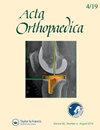Association of osteotomy, age, and component fixation with the outcomes of total hip arthroplasty in patients with hip dysplasia: a Dutch population-based registry study.
IF 2.5
2区 医学
Q1 ORTHOPEDICS
引用次数: 0
Abstract
BACKGROUND AND PURPOSE Hip dysplasia can present challenges for total hip arthroplasty (THA) due to anatomic abnormalities. We aimed to assess the association of age, sex, osteotomies prior to THA, and fixation method on 5- and 10-year revision-free implant survival and patient-reported outcome measures (PROMs) of THAs in patients with hip dysplasia. METHODS Using Dutch Arthroplasty Register data, we studied hip dysplasia patients receiving primary THAs in 2007-2021 (n = 7,465). THAs were categorized by age, pelvic osteotomy prior to THA (yes/no), and fixation (cemented, uncemented, hybrid, reverse hybrid). Kaplan-Meier and multivariable Cox models were used to determine 5- and 10-year revision-free implant survival and adjusted hazard ratios including 95% confidence intervals (CIs). Reasons for revision and PROMs were compared within the categories. RESULTS We found a 10-year revision-free implant survival of 94.9% (CI 94.3-95.5). Patients younger than 50 years had a 10-year implant survival of 93.3% (CI 91.9-94.7), Patients with prior pelvic osteotomy had a 10-year implant survival of 92.0% (CI 89.8-94.2). Fixation method and sex were not associated with implant survival. Patients with a prior pelvic osteotomy had more revisions due to cup loosening and reported lower PROM scores than patients without earlier osteotomy. CONCLUSION 5- and 10-year revision-free implant survival rates of THA for hip dysplasia are 96.4% and 94.9%. Age and prior osteotomies were associated with decreased implant survival rates in patients with hip dysplasia, while fixation method was not. Prior osteotomies were also associated with reduced PROM scores.髋关节发育不良患者的截骨术、年龄和组件固定与全髋关节置换术结果的关系:一项基于荷兰人口的登记研究。
背景和目的由于解剖异常,髋关节发育不良会给全髋关节置换术(THA)带来挑战。我们旨在评估髋关节发育不良患者的年龄、性别、THA 前的截骨情况和固定方法与 5 年和 10 年无翻修植入物存活率和患者报告的 THAs 结果测量指标 (PROM) 的关系。方法利用荷兰关节成形术登记数据,我们研究了 2007-2021 年接受初次 THAs 的髋关节发育不良患者(n = 7465)。THA按照年龄、THA前骨盆截骨(是/否)和固定方式(骨水泥、非骨水泥、混合、反向混合)进行分类。采用 Kaplan-Meier 和多变量 Cox 模型确定 5 年和 10 年无翻修植入物存活率和调整后的危险比,包括 95% 置信区间 (CI)。结果我们发现,10 年无翻修植入物存活率为 94.9% (CI 94.3-95.5)。年龄小于 50 岁的患者 10 年种植体存活率为 93.3% (CI 91.9-94.7),曾行骨盆截骨术的患者 10 年种植体存活率为 92.0% (CI 89.8-94.2)。固定方法和性别与植入物存活率无关。与未行截骨术的患者相比,曾行骨盆截骨术的患者因髋臼杯松动而进行的翻修次数更多,PROM评分更低。年龄和既往截骨术与髋关节发育不良患者植入物存活率的降低有关,而固定方法与之无关。既往截骨手术也与PROM评分降低有关。
本文章由计算机程序翻译,如有差异,请以英文原文为准。
求助全文
约1分钟内获得全文
求助全文
来源期刊

Acta Orthopaedica
医学-整形外科
CiteScore
6.40
自引率
8.10%
发文量
105
审稿时长
4-8 weeks
期刊介绍:
Acta Orthopaedica (previously Acta Orthopaedica Scandinavica) presents original articles of basic research interest, as well as clinical studies in the field of orthopedics and related sub disciplines. Ever since the journal was founded in 1930, by a group of Scandinavian orthopedic surgeons, the journal has been published for an international audience. Acta Orthopaedica is owned by the Nordic Orthopaedic Federation and is the official publication of this federation.
 求助内容:
求助内容: 应助结果提醒方式:
应助结果提醒方式:


